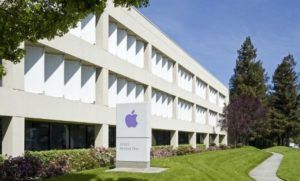By Thomas R. Stelmack, Class of 2017
This 4-part series covers Apple Architecture from its corporate beginnings in a now landmarked garage to the current design concept as epitomized by Apple Park.
1. Part 1 Chicago’s Apple store. Its design and how has set trends for those that follow.
2. Part 2 Apple Park’s Architecture and its influence on subsequent Apple Stores
3. Part 3 Apple’s Architecture parallels its corporate history, culminating in Apple Park
4. Part 4 will introduce the architects who influenced Apple Architecture.
Founded in 1976 by Steve Wozniak and Steve Jobs as a personal computer company, Apple was amid a myriad of introductions to the same market. Osbourne, Radio Shack, Altair, Zenith, IBM, Compaq, Hewlett Packard, Atari, and Commodore were among them. Despite a loyal following and a long run of eight years, the Apple II & III began to lose market share. Other desktop Apple systems were introduced such as Macs, but their market share and profitability did not significantly improve. In 1985, Steve Jobs was forced out of the company. For the next 10 years after his departure, few significant advancements were made at Apple under the leadership of CEOs John Sculley, Michael Spindler.
In late 1996, as co-founder Steve Jobs returned to the company following his 1985 exile, Apple experienced a marked resurgence. Jobs had developed the operating system NeXTstep in his company NeXT. Apple had just acquired NeXTstep, bringing Jobs back to Apple in an ‘expanded role’. That operating system would become the foundation of Apple’s Rhapsody operating system. Under Jobs’ direction, through a series of consolidations, agreements with Microsoft, retailing (online & storefront), and new systems introductions, Apple was again profitable. By 2000 Jobs became CEO.
He introduced the personalized “i” concept beginning with the iTools approach to internet computing. Later this was extended to the iDVD and iTunes, eventually leading to iPod, iPads, and iPhones. The enthusiasm spread to the Mac line of laptops following the failure of the Cube design. The Apple “i” concept now plays a dominant role in the smart phone and PC industries. With that rise in market dominance, the company’s physical architecture followed.

The company’s architecture began modestly. Apple 1 computers, nothing more than a circuit board, were built at 2066 Crist Dr. in Los Altos in a garage owned by Steven Jobs’ adopted parents (right). Designed in the mid-1950s by an unknown architect, it is now an historic landmark. (figure 1, left)
From the early 1970s, Apple’s headquarters were located at 20863 Stevens Creek Boulevard, Cupertino, California. It was a non-descript building (figure 2), but the company was quite small during its initial phase. Apple moved to 10260 Bandley Drive, Cupertino, in 1978 (figure 3). More buildings were added next door, including Bandley 3 (figure 4). Then in 1982, a new structure was built at 20525 Mariani Avenue, Cupertino, CA (figure 5).
When Steve Jobs was removed from Apple by John Scully in 1985, he founded NeXT, and that company resided in two campuses. Each office space in Palo Alto, CA contained design elements by I.M. Pei. (1) A glass and concrete building featured his designed staircase. In need of additional space, the company later rented an office at 800 and 900 Chesapeake Drive in Redwood City, also designed by Pei. The architectural centerpiece was a “floating” staircase with no visible supports. Pei is a Chinese-American “Starchitect” who won both the Pritzker Prize and AIA Gold.
Beginning in 1993, Apple Computer World Headquarters, with adjacent research buildings, was located on the Apple Campus at the southeast corner of Interstate 280 and De Anza Boulevard. It occupies 32 acres (130,000 m) (2) and is comprised of six buildings configured as an “infinity loop”. This is computer nomenclature that describes a sequence of computer instructions that is either endless due to a programming error, or intentionally loops ad infinitum. The Sobrato Development Company, the leading developers of technology facilities in Silicon Valley, designed and built this campus. (John Sobrato was for a short time the wealthiest man in the U.S.) The site resembles a university ( figures 6, 7, & 8). This design concept carried forward to the new Park.
The Apple Campus was supplanted by the newly constructed Apple Park, It is expected to become an historical architectural structure, notable for blending into its environment as well as maintaining a limited carbon footprint. This Park signifies the remarkable ascension of a tiny company to the largest by market share.

References:
[1] https://en.wikipedia.org/wiki/NeXT
[2] https://en.wikipedia.org/wiki/Starchitect








